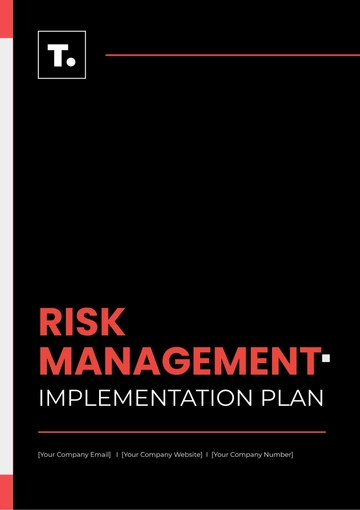Free Marketing Product Launch Risk Management Plan

Management Plan
Executive Summary
The Marketing Product Launch Risk Management Plan is a critical document that guides our approach to the launch of our groundbreaking product, [Product Name] This comprehensive plan outlines how we will identify, assess, mitigate, and monitor risks associated with this high-stakes event. By proactively managing these risks, we aim to ensure the successful market entry of "[Product Name]" while protecting our company's reputation and financial stability.
A. Purpose of the Product Launch
The launch of "[Product Name]" represents a significant milestone for our company. This advanced product is designed to revolutionize the industry by offering cutting-edge features and unparalleled value to our customers. The success of this launch is paramount not only for our profitability but also for establishing our leadership in the market.
B. Importance of Risk Management
In any product launch, there are inherent uncertainties and potential obstacles that can impact our goals. Effective risk management is essential to anticipate, prepare for, and mitigate these challenges. By taking a proactive approach to risk management, we can minimize disruptions, maintain our competitive edge, and optimize the return on our investment.
C. Key Objectives of this Plan
The key objectives of this risk management plan are as follows:
To systematically identify potential risks associated with the "[Product Name]" product launch.
To assess the severity and likelihood of each identified risk.
To develop and implement risk mitigation strategies to minimize the impact of these risks.
To establish a robust monitoring and control system for ongoing risk assessment.
To ensure clear and effective communication with stakeholders throughout the launch process.
To create contingency plans for high-impact risks, ensuring quick and effective responses if they materialize.
Introduction
A. Product Overview
"[Product Name]" is a cutting-edge productivity software suite designed for professionals and businesses. It offers a wide range of features, including project management, data analytics, and collaboration tools. The product's unique selling points include cloud-based accessibility, robust security features, and seamless integration with popular business software.
B. Launch Objectives
The objectives of the "[Product Name]" product launch are as follows:
Achieve a 20% increase in market share within the first year of launch.
Generate $10 million in revenue within the first six months.
Establish "[Product Name]" as the industry standard for productivity software.
Garner positive media coverage and reviews from industry influencers.
Build a strong customer base and secure long-term partnerships with key clients.
C. Stakeholders and Roles
Stakeholders involved in the "[Product Name]" product launch include:
Executive Team: Responsible for overall strategy and decision-making.
Product Development Team: In charge of product design, development, and quality assurance.
Marketing Team: Responsible for creating and executing marketing campaigns.
Sales Team: Tasked with promoting and selling "[Product Name]" to clients.
Customer Support Team: Ensures customer satisfaction and provides post-launch support.
External Partners: Includes PR agencies, suppliers, and distributors.
Risk Identification
A. Market Research Risks
Market research is a critical phase of our launch strategy. However, it comes with inherent risks:
Data Accuracy: There's a risk that the data we collect may not accurately reflect market trends or customer preferences. This can lead to misguided marketing efforts.
Biases: Bias in the data collection process can skew our understanding of the market, potentially causing us to make decisions based on flawed information.
Outdated Information: Relying on outdated market information may result in launching a product that doesn't address current customer needs.
B. Product Development Risks
Our product development process is complex, and there are several associated risks:
Technical Challenges: Complex software development may encounter technical challenges that cause delays or quality issues.
Manufacturing Delays: For physical components of our product, manufacturing delays can disrupt our launch timeline.
Quality Control: Ensuring high-quality software and hardware components is crucial. Quality control issues can damage our reputation.
C. Competition Risks
In the competitive landscape of productivity software, we must be vigilant:
Aggressive Competitors: Competitors may respond aggressively to our launch, potentially leading to price wars or aggressive marketing campaigns.
Market Saturation: If the market is saturated, gaining a foothold may be challenging.
Innovative Disruption: Competitors might introduce disruptive innovations that could undermine our product's appeal.
D. Supply Chain Risks
For physical components of "[Product Name]," supply chain risks are a concern:
Supplier Reliability: If our suppliers encounter issues, it can lead to delays in production and delivery.
Logistics Challenges: Transportation and logistics issues can disrupt the timely delivery of physical products to customers.
Risk Assessment
A. Severity of Impact
We evaluate the potential impact of each risk on the "[Product Name]" product launch:
Market Research Risks: The impact of inaccuracies or biases in market research could range from minor marketing adjustments to a significant change in product strategy.
Product Development Risks: Technical challenges may cause moderate delays and quality issues, affecting our reputation and initial sales.
Competition Risks: Aggressive competitor responses could lead to pricing pressures and increased marketing expenditures, impacting profitability.
Supply Chain Risks: Supply chain disruptions may result in delayed product availability, affecting revenue and customer satisfaction.
B. Likelihood of Occurrence
We assess the likelihood of each risk occurring:
Market Research Risks: Likelihood is moderate, given rigorous data collection and validation processes.
Product Development Risks: Likelihood is low, as we have an experienced development team and thorough testing procedures.
Competition Risks: Likelihood is high due to the competitive nature of the industry.
Supply Chain Risks: Likelihood is moderate, considering potential disruptions in the global supply chain.
Risk Mitigation Strategies
A. Market Research Risks Mitigation
Risk | Mitigation Strategy | Responsible Party | Timeline |
Inaccurate Data | Conduct third-party audits of market data | Market Research Team | Before launch |
Bias in Data | Implement data validation and diversity in data sources | Market Research Team | Ongoing |
Outdated Information | Regularly update market data and trends analysis | Market Research Team | Quarterly |
B. Product Development Risks Mitigation
Risk | Mitigation Strategy | Responsible Party | Timeline |
Technical Challenges | Establish a dedicated technical support team | Product Development Team | Before launch |
Manufacturing Delays | Identify alternative suppliers and monitor production closely | Supply Chain Team | Ongoing |
Quality Control Issues | Implement rigorous quality assurance protocols | Quality Assurance Team | Throughout development |
C. Competition Risks Mitigation
Risk | Mitigation Strategy | Responsible Party | Timeline |
Aggressive Competitors | Monitor competitor actions and adjust marketing strategies | Marketing Team | Ongoing |
Market Saturation | Explore niche markets and diversify product offerings | Executive Team | Throughout launch |
Innovative Disruption | Stay updated on industry trends and adapt product features accordingly | Product Development Team | Ongoing |
D. Supply Chain Risks Mitigation
Risk | Mitigation Strategy | Responsible Party | Timeline |
Supplier Reliability | Establish backup suppliers and maintain strong relationships | Supply Chain Team | Before launch |
Logistics Challenges | Develop contingency logistics plans and diversify transport options | Supply Chain Team | Before launch |
Risk Monitoring and Control
A. Ongoing Risk Monitoring
We will establish regular risk assessment meetings involving key stakeholders to review the status of identified risks.
B. Trigger Points for Contingency Plans
Contingency plans will be initiated when risks reach predefined trigger points. These points will be based on the severity and likelihood assessments made in Risk Assessment.
Communication Plan
Effective communication is paramount in risk management and ensuring a successful product launch.
A. Internal Communication
Clear and timely internal communication is essential for effective risk management:
Regular Team Meetings: We will conduct regular cross-functional team meetings to discuss risk status, mitigation progress, and any emerging issues.
Risk Dashboards: Implementing risk dashboards that provide real-time updates on risk status to all relevant teams and stakeholders.
Escalation Protocols: Establishing clear escalation protocols ensures that issues are promptly raised to the appropriate level of management.
B. External Communication
Externally, we will maintain transparency and manage stakeholder expectations:
Stakeholder Updates: Regular updates will be provided to investors, partners, and clients about the progress of the product launch and any associated risks.
Media Strategy: We will coordinate with our PR agency to ensure a consistent and positive narrative in the media, addressing any concerns or challenges proactively.
Customer Support Communication: In the event of any disruptions, our customer support team will maintain open channels of communication with affected customers to provide timely solutions and address concerns.
Contingency Plan
A. High-Impact Risk Contingency Plan
We have identified high-impact risks that require dedicated contingency plans:
Market Saturation: In the event of market saturation, we will pivot to explore niche markets and refine our product offering to cater to specific industry needs.
Manufacturing Delays: Should manufacturing delays occur, we will activate our backup suppliers and adjust our delivery timeline to minimize disruption.
Aggressive Competitor Response: In response to aggressive competitor actions, we will carefully review our pricing and marketing strategies to maintain our competitive edge.
B. Communication of Contingency Plans
Clear communication of contingency plans is essential:
Internal Teams: All internal teams will be briefed on the contingency plans specific to their areas of responsibility, ensuring a coordinated response.
Stakeholders: External stakeholders, including investors and partners, will be informed of the activation of contingency plans and the measures being taken to mitigate risks.
Customers: In the case of product delays or disruptions, customers will receive transparent and timely communication outlining the steps being taken to resolve issues and minimize impact.
The Marketing Product Launch Risk Management Plan serves as a comprehensive and proactive strategy to ensure the successful launch of our innovative product, [Product Name] By systematically identifying, assessing, mitigating, and monitoring risks, we aim to protect our company's reputation, financial stability, and market leadership. Throughout this plan, we have established clear risk mitigation strategies, robust communication protocols, and contingency plans to address potential challenges that may arise during the launch.
The success of the "[Product Name]" product launch is not only critical for achieving our market share and revenue objectives but also for establishing our brand as a leader in the industry. As we move forward with the launch, it is imperative that we remain agile, adaptable, and vigilant in our risk management efforts. Regular risk assessments and updates will ensure that we respond effectively to changing circumstances and emerging threats.
- 100% Customizable, free editor
- Access 1 Million+ Templates, photo’s & graphics
- Download or share as a template
- Click and replace photos, graphics, text, backgrounds
- Resize, crop, AI write & more
- Access advanced editor
Optimize your product launch strategy with Template.net's Marketing Product Launch Risk Management Plan Template. Fully editable and customizable, this comprehensive resource empowers you to assess and mitigate risks effectively. Seamlessly modify and tailor it to your specific needs using our Ai Editor Tool. Ensure a smooth and successful product introduction.
You may also like
- Finance Plan
- Construction Plan
- Sales Plan
- Development Plan
- Career Plan
- Budget Plan
- HR Plan
- Education Plan
- Transition Plan
- Work Plan
- Training Plan
- Communication Plan
- Operation Plan
- Health And Safety Plan
- Strategy Plan
- Professional Development Plan
- Advertising Plan
- Risk Management Plan
- Restaurant Plan
- School Plan
- Nursing Home Patient Care Plan
- Nursing Care Plan
- Plan Event
- Startup Plan
- Social Media Plan
- Staffing Plan
- Annual Plan
- Content Plan
- Payment Plan
- Implementation Plan
- Hotel Plan
- Workout Plan
- Accounting Plan
- Campaign Plan
- Essay Plan
- 30 60 90 Day Plan
- Research Plan
- Recruitment Plan
- 90 Day Plan
- Quarterly Plan
- Emergency Plan
- 5 Year Plan
- Gym Plan
- Personal Plan
- IT and Software Plan
- Treatment Plan
- Real Estate Plan
- Law Firm Plan
- Healthcare Plan
- Improvement Plan
- Media Plan
- 5 Year Business Plan
- Learning Plan
- Marketing Campaign Plan
- Travel Agency Plan
- Cleaning Services Plan
- Interior Design Plan
- Performance Plan
- PR Plan
- Birth Plan
- Life Plan
- SEO Plan
- Disaster Recovery Plan
- Continuity Plan
- Launch Plan
- Legal Plan
- Behavior Plan
- Performance Improvement Plan
- Salon Plan
- Security Plan
- Security Management Plan
- Employee Development Plan
- Quality Plan
- Service Improvement Plan
- Growth Plan
- Incident Response Plan
- Basketball Plan
- Emergency Action Plan
- Product Launch Plan
- Spa Plan
- Employee Training Plan
- Data Analysis Plan
- Employee Action Plan
- Territory Plan
- Audit Plan
- Classroom Plan
- Activity Plan
- Parenting Plan
- Care Plan
- Project Execution Plan
- Exercise Plan
- Internship Plan
- Software Development Plan
- Continuous Improvement Plan
- Leave Plan
- 90 Day Sales Plan
- Advertising Agency Plan
- Employee Transition Plan
- Smart Action Plan
- Workplace Safety Plan
- Behavior Change Plan
- Contingency Plan
- Continuity of Operations Plan
- Health Plan
- Quality Control Plan
- Self Plan
- Sports Development Plan
- Change Management Plan
- Ecommerce Plan
- Personal Financial Plan
- Process Improvement Plan
- 30-60-90 Day Sales Plan
- Crisis Management Plan
- Engagement Plan
- Execution Plan
- Pandemic Plan
- Quality Assurance Plan
- Service Continuity Plan
- Agile Project Plan
- Fundraising Plan
- Job Transition Plan
- Asset Maintenance Plan
- Maintenance Plan
- Software Test Plan
- Staff Training and Development Plan
- 3 Year Plan
- Brand Activation Plan
- Release Plan
- Resource Plan
- Risk Mitigation Plan
- Teacher Plan
- 30 60 90 Day Plan for New Manager
- Food Safety Plan
- Food Truck Plan
- Hiring Plan
- Quality Management Plan
- Wellness Plan
- Behavior Intervention Plan
- Bonus Plan
- Investment Plan
- Maternity Leave Plan
- Pandemic Response Plan
- Succession Planning
- Coaching Plan
- Configuration Management Plan
- Remote Work Plan
- Self Care Plan
- Teaching Plan
- 100-Day Plan
- HACCP Plan
- Student Plan
- Sustainability Plan
- 30 60 90 Day Plan for Interview
- Access Plan
- Site Specific Safety Plan





























